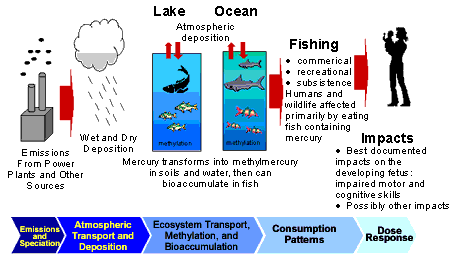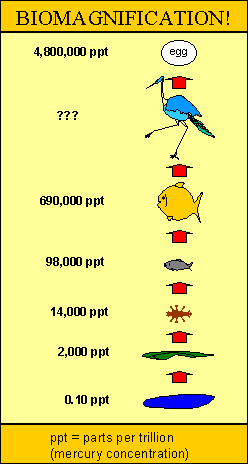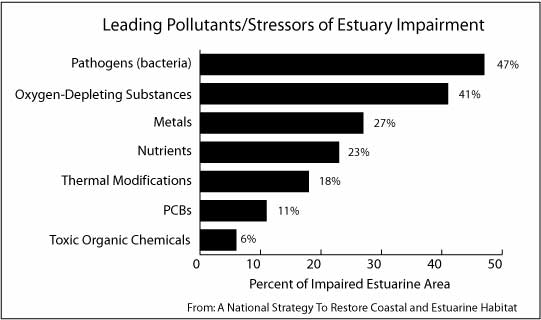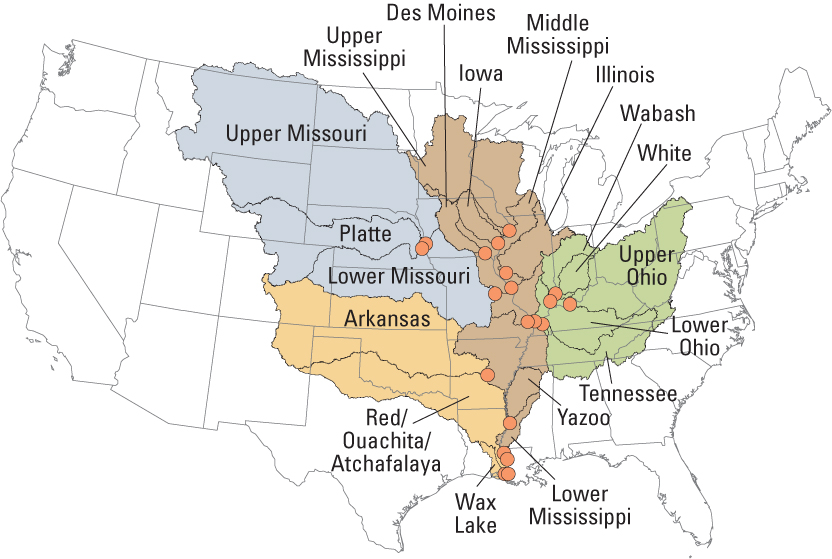
Introduction to Coastal Pollution
Importance of Coastal Regions
Coastal waters are important for many reasons:
- People like to live near the coast. 38% of the world's population
lives within 100 km of the coast. Small and Cohen (2004).
It was estimated that in 2003, approximately 153 million people (53 percent of the nation’s population) lived in the 673 U.S. coastal counties, an increase of 33 million people since 1980... Coastal counties constitute only 17 percent of the total land area of the United States (not including Alaska), but account for 53 percent of the total population. 23 of the 25 most densely populated U.S. counties are coastal.
Population Trends Along the Coastal United States: 1980-2008 (Crossett, 2004).
- Many people like to go to the beach for recreation and relaxing.
$8 to $10 billion is generated each year in the U.S. by coastal activities
such as canoeing and kayaking, bird watching, swimming, sport fishing,
and tourism.
Coastal areas are also subject to major population influxes during peak vacation periods. Ocean City, MD, for example, had almost 4 million seasonal visitors between the Memorial Day and Labor Day holidays in 2003.
Population Trends Along the Coastal United States: 1980-2008 (Crossett, 2004).
- Coastal areas are a physical buffer protecting communities near the
coast from storm surges and flooding.
- Most of the important oceanic fisheries are on the continental shelf
close to the coast.
- Most of the oil and gas taken from the sea floor comes from the continental
shelf and slope.
- Estuaries are the nursery for many fish and shellfish, and they are
home for much wildlife.
- 75% of commercially harvested fish and shell fish depend on estuaries and nearby coastal waters for some part of their life cycle.
- The Chesapeake Bay supports more than 3,000 migratory and resident species of wildlife.
- Puget Sound supports 220 species of fish, 100 species of shore and sea birds, and 26 species of marine mammals.
- Galveston Bay supports more than 162 species of fish.
Let me say again: The Laguna Madre, and places like it throughout the world are natural fish hatcheries for our oceans. Fish come into these areas to spawn, then return to the Gulf.
Grigar (1997) page 92.
Pollution Defined
The word pollution comes from the verb pollute, which means to make unpure. Thus pollution is:
The action of polluting, or condition of being polluted; defilement; uncleanness or impurity caused by contamination (physical or moral). spec. The presence in the environment, or the introduction into it, of products of human activity which have harmful or objectionable effects.
From the Oxford English Dictionary.
Notice that pollution is the product of human activity.
Coastal Waters are in Trouble
Pollution in coastal waters is bad in many areas, it is getting worse, and more and more areas are affected. According to A National Strategy to Restore Coastal and Estuarine Habitat:
- 95% of San Francisco Bay's original wetlands have been destroyed.
- 85% of Galveston Bay's sea grass meadows are gone.
- More than 30% of Connecticut's coastal wetlands have been lost.
- 25 square miles of coastal Louisiana wetlands disappear each year.
- Oyster harvests in Chesapeake Bay plummeted from 25 million pounds to one million pounds in just 30 years.
- The number of wild salmon returning to Maine's rivers has dropped 80% in the last ten years.
There are Many Types of Coastal Pollution.
- Bacteria and viruses (pathogens).
- Oxygen-depleting substances such as sewage, other carbon-based waste, and dissolved carbon-based material,
- Toxic substances such as:
- Heavy metals, especially in carbon-based
compounds:
- Arsenic
- Cadmium
- Cobalt
- Copper
- Lead
- Mercury,
especially methyl mercury

From Environmental Protection Agency: How Mercury Enters the Environment.
- Manganese
- Tin
- Selenium
- Zinc
- Uranium
- Industrial waste products such as polychlorinated
biphenyls,
Polychlorinated biphenyls are mixtures of up to 209 individual chlorinated compounds (known as congeners). There are no known natural sources of PCBs. PCBs are either oily liquids or solids that are colorless to light yellow. Some PCBs can exist as a vapor in air. PCBs have no known smell or taste. Many commercial PCB mixtures are known in the U.S. by the trade name Aroclor.
PCBs have been used as coolants and lubricants in transformers, capacitors, and other electrical equipment because they don't burn easily and are good insulators. The manufacture of PCBs was stopped in the U.S. in 1977 because of evidence they build up in the environment and can cause harmful health effects. Products made before 1977 that may contain PCBs include old fluorescent lighting fixtures and electrical devices containing PCB capacitors, and old microscope and hydraulic oils.
From U.S. Department of Health and Human Services, Agency for Toxic Substances and Disease Registry ToxFAQs.
- Toxic carbon-based compounds (herbicides, pesticides),
- Heavy metals, especially in carbon-based
compounds:
- Nutrients (nitrates, phosphates),
- Hot water discharge from power plants,
- Alien species, such as the European Green Crab and the aquatic weed Carcinus maenas on the US west coast.
- Litter. There are three types:
- Monofilament fishing line, fishing nets, and tackle.
- Abandoned fishing boats, docks, and structures.
- Small objects, including plastic rings used to hold 6-packs of cold drinks, cigarette butts, and tires.
- Noise, especially noise that
interferes with marine mammals and other animals communications and
hearing.
The ocean environment has always included an abundance of natural noises, such as the sounds generated by rain, waves, earthquakes, and sea creatures. However, a growing number of ships and oil rigs, as well as increased use of sonar by navies and researchers, is adding to the natural noise that already surrounds marine life. Although noise in the sea has increased steadily since the Industrial Revolution, there is little information on exactly how noisy it has become or how marine mammals in particular react to the noise. Nevertheless, recent episodes in which dolphins and whales have beached themselves while human-generated sounds were being deployed nearby have raised questions about the impact of ocean noise.
From National Academy of Sciences Report on Ocean Noise and Marine Mammals
Top Seven Pollutants
Pollution has many consequences.
- It may be concentrated to
dangerous levels by marine animals such as shellfish. Eating polluted
shellfish can cause serious illness (see Harmful
Algal Blooms). Animals
at the top of the food chain, such as tuna, have the greatest concentrations
of some pollutants such as mercury. Note it is the concentration of
the pollutant that is important, not the total amount in the animal.
Phytoplankton have small concentrations, predators can have much higher
concentrations.
The increase in concentration of pollutants is called bio-magnification or bio-accumulation.

From Environmental Protection Agency: Methylmercury Exposure.

Mercury concentrations in parts per trillion increase as the trophic level of aquatic animals increases in south Florida, an region with high levels of mercury pollution. From US Geological Survey: South Florida Restoration Science Forum.
- For
a very interesting, well-argued study of mercury in the ocean, its
occurrence in tuna, and the regulation of mercury exposure for pregnant
women, read the Mercury
Science Findings in People of the State of California vs. Tri-Union
Seafoods (6.2 MByte PDF file).
Superior Court Judge Robert L. Dondero finds methylmercury levels in ocean fish “virtually natural in origin,” and mercury alarm scientists have “credibility problems.” Finds study underlying EPA’s mercury RfD confounded, unreliable and without “statistically significant relationship.”
From Center for Science and Public Policy web page on Mercury.
- Pollution may kill
off a thriving tourist business in a coastal region.
- Dangerous species may become common, causing health problems, and
interfering with tourism and fisheries. A few years
ago, a new organism was found in some estuaries along the east coast: Pfiesteria
piscicida. It killed fish. It seemed to cause sores and
memory loss in people who handled the dead fish. Where do these
organisms come from? For more see the Pfiesteria web
site.
- It may kill marine life, e.g. birds caught in plastic
rings used to hold 6-packs of cold drinks.
- Large quantities of nutrients and carbon-based waste leads to plankton blooms. When the plants die, they sink to the bottom, decay, and reduce the oxygen in deeper waters, e.g. the Gulf of Mexico Hypoxia (dead) Zone caused by Mississippi River runoff.
Mississippi River Basin. From US Environmental Protection Agency.
References
Crossett, K. M., T. J. Culliton, et al. (2004). Population trends along the coastal United States: 1980-2008, NOAA National Ocean Service, Management and Budget Office: 54.
Grigar, R. and W. R. McAlfee (1997). Plugger: Wade Fishing the Gulf Coast, Texas Tech University Press.
Small, C. and J. E. Cohen (2004). Continental Physiography, Climate, and the Global Distribution of Human Population1. Current Anthropology 45 (2).
Revised on: 30 May, 2017


